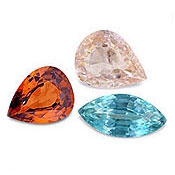Zircon
(zur-kon)
HISTORY and LORE
- Sometimes confused with synthetic cubic zirconia (the popular diamond imitation better known as CZ). But zircon is a natural gem that has been prized in both the East and West for many centuries. Until modern times it was called jacinth, hyacinth, or jargon.
- Name may come from Arabic zarkun meaning vermilion, or from even older Persian zargun, which translates “golden colored”. Either term might describe the tints of some zircons.
- Traditionally believed to offer protection from evil, guarantee safe travel, bring its wearer wealth, wisdom, and hone – and assure a good night’s sleep.
- Birthstone or December.
VALUE FACTORS
- Color: Most popular is blue, ranging from pale pastel to the distinctive bright greenish blue known as “zircon blue” in the gem trade. Also colorless plus shades of orange, yellow, brown, green, red, pink, and occasionally purple.
- Clarity: Blue and colorless zircon is typically almost inclusion-free. Other colors are often lightly included, and minor clarity characteristics are accepted.
- Cut: Usually faceted in traditional shapes and styles. A favorite for blue is the zircon cut, which is the same style used for round diamonds, but with an extra row of facets around the bottom.
- Carat Weight: Blue is normally available in all jewelry sizes (up to 15 or 20 carats). Other colors are rare over about 8 or 10 carats.
TREATMENT
Virtually all blue, red, and colorless zircon is produced by heat treatment. Some orange and yellow is too. This process duplicates heating that can occur naturally in the earth. The effects are usually permanent, but some heat-treated zircons gradually revert to their original color. (Prolonged exposure to intense light increases this possibility.) Heat treatment can also reduce toughness, requiring more careful wear.
GEMOLOGY
- Zircon is classified as a mineral species. Composed primarily of zirconium, silicon, and oxygen; chemical formula ZrSiO4. Color is usually caused by crystal structure distortion resulting from low levels of natural radiation emitted over hundreds of millions of years by trace amounts of elements such as thorium and uranium.
- Zircon is one of the few colored gems that show the optical effect known as dispersion. This occurs when white light spreads into spectral colors. Rainbows provide the most spectacular examples of dispersion, and it’s a key factor in the appeal of diamonds. To see it in zircon, use full-spectrum display lights or direct sun, rock the gem gently, and look for flashes of rainbow fire. (Deep color may mask the effect.)
CARE
Zircon generally has fair wearabiltiy. Protective setting is recommended.
- Hardness: Moderate scratch resistance. Rates 6 to 7.5 on the Mohs Hardness Scale.
- Toughness: Good to fair resistance to chipping and breaking (largely depending on the type and extent of clarity characteristics). Heat treatment can also make zircon somewhat brittle.
- Stability: No routine concerns for gem owners.
- Cleaning: Liquid cleaner, or detergent and water. NEVER USE AN ULTRASONIC.
